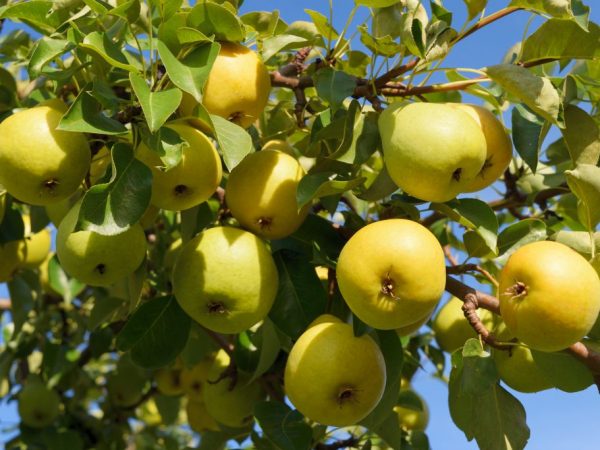Characteristics of the Lel variety pear
Pear Lel is a popular domestic variety. Growers note good yields, high taste, and versatility in fruit consumption. Growing this crop won't be a big deal.

Characteristics of the Lel variety pear
Description of the variety
Bred by breeders in 1969 I.A. Puchkin, I.P. Kalinina, E.P. Karataeva and M.I. Borisenko in Siberia. Two well-known species became parents: Yakovleva's Favorite and Vinnaya. Zoned in the Western and Eastern regions of Siberia, as well as in the Urals.
The variety belongs to the early-growing - you can feast on fruits already 4 years after planting. Summer pear. Harvested in mid-August.
Description of the tree
The culture is of medium size - it grows in height up to 4-6 m. The crown has the shape of an ellipse, the thickening is average. The foliage is good. Shoots are long, curved in an arc, with a pile at the tips. Their color is dark brown with a reddish tint. Leaves are small, dark green, matte. Has a bulge along the central vein.
Description of the fetus
The shape of the fruit is wide pear-shaped, regular. The sizes are small. The average weight is 60-80 g, in some it can reach up to 100 g. The skin is smooth, not thick, glossy. The color at the stage of removable maturity is green, when fully ripe it is yellow-green. A slight striped blush is characteristic. Numerous green spots are visible under the skin. The peduncle is long, thin. The pulp is juicy, semi-oily, white. The taste is sweet and sour with a spicy touch. Dessert pear is consumed fresh, compotes are prepared.
Advantages and disadvantages
In the description of the Lel pear variety, positive and negative characteristics are distinguished. The advantages include the following properties:
- good and stable yield - up to 40 kg of fruit are harvested from one tree;
- quickness;
- early ripening (when there are no imported pears yet);
- high taste;
- frost resistance above average;
- is immune to certain diseases.
Weaknesses are as follows:
- poor preservation - only up to 7 days;
- do not withstand transportation;
- wood is demanding on moisture;
- late flowering.
Care

Lel variety needs sunlight
Pear variety Lel prefers well-lit places with deep groundwater. The area where the dew is grown must be protected from strong winds. Protection can be provided with various kinds of structures or with the help of other trees. It does not have any special requirements for the soil.
After planting, at first, it is necessary to organize a garter for the seedling. This will prevent him from breaking. For this purpose, a peg is driven into the ground, to which a tree is attached.
The harvest will delight in performance if you take good care of the pear. To do this, you need to follow simple rules.
Watering
Adequate moisture is one of the main growing conditions. Watering should be regular and abundant - about 2 times a week.The main thing is not to overdo it, so you need to add liquid as the top layer of the soil dries. Water is taken warm to avoid hypothermia of the root system.
Loosening the soil
In order to retain moisture, the soil is loosened after watering or rain. During the summer period, up to 4 such procedures are performed. The near-stem section is loosened 10 cm in depth. In autumn - by 15 cm.In the spring, harrowing is done first, followed by cultivation to a depth of 12 cm.
In order not to damage the roots of the tree, it is necessary to loosen the soil no deeper than 35-45 cm. Near the plant itself, manipulations must be done manually. They also do weeding from the earth. If the gardener uses mulching of near-stem circles, loosening is not performed, only weeds are removed.
Top dressing
The culture needs fertilization throughout its life. They are not used only in the first year. If the planting was done correctly, then there are enough nutrients for this period. With growing culture, feeding is used in 3 stages:
- in the spring;
- in summer;
- in the fall.
To build up green mass in spring, nitrogen-containing agents are used.
From organics, an infusion of chicken manure is used (0.5 kg of substance per 10 liters of warm water). Also used are chemicals such as ammonium nitrate, carbamide, urea.
Some gardeners skip summer dressing. If the plants are well fertilized in the spring, then there will be enough nutrients for pouring and ripening the fruits.
To prepare the tree for winter, fertilizers containing potassium and phosphorus are used. Complex mineral preparations will be effective. It is necessary to dose all substances strictly according to the instructions, because the arrogant amount of some elements has a bad effect on the state of the pear.
Pruning
They carry out sanitary cleaning of the tree - remove dried and damaged branches. This prevents the development of diseases.
Diseases - pests
The resistance of the Lel pear variety to diseases is quite high, especially to such as:
- eptoriasis;
- coccomycosis;
- bacterial cancer;
- fruit rot;
- spotting.
To increase immunity, preventive treatments can be carried out.
For this purpose, copper sulfate, iron sulfate, Bordeaux liquid are used. Insecticides are used to control pests. The drug "Agravertin" will cope with the moth, "Kinmix" - with aphids, "Tsimbush" - with a leaf roll.
Conclusion
The pear variety Lel, whose fruits ripen quickly and have excellent taste, has proven itself well in cultivation. Proper care will be the key to a good harvest.


